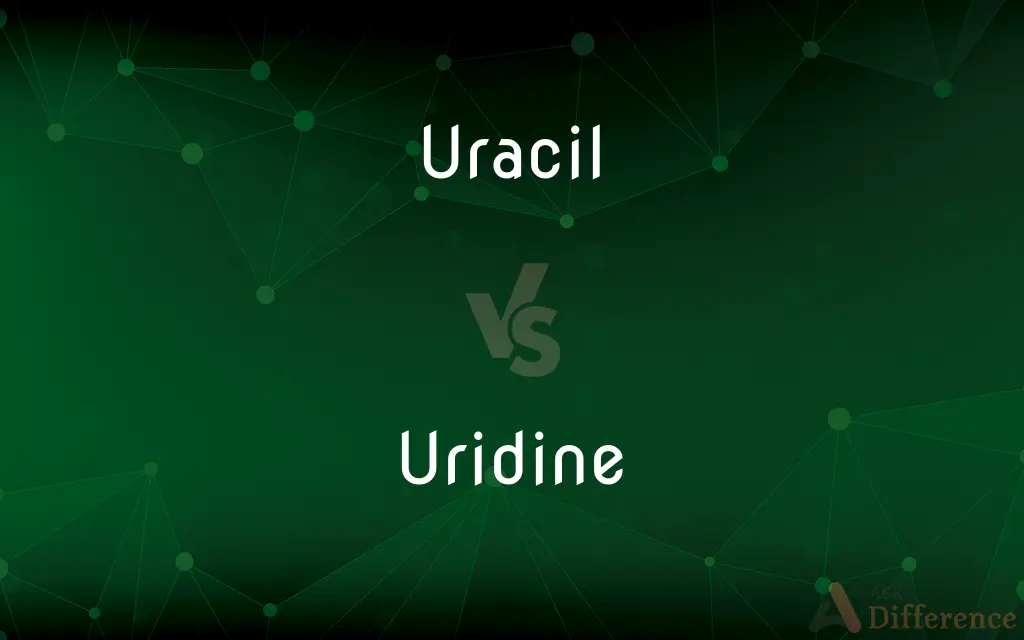Uracil vs. Uridine — What's the Difference?
By Tayyaba Rehman & Urooj Arif — Updated on March 10, 2024
Uracil is a nitrogenous base found in RNA, essential for genetic coding and expression, while uridine is a nucleoside comprising uracil attached to a ribose sugar.

Difference Between Uracil and Uridine
Table of Contents
ADVERTISEMENT
Key Differences
Uracil plays a crucial role in RNA, replacing thymine (found in DNA) and pairing with adenine during RNA transcription. On the other hand, uridine, which includes uracil, expands its function beyond genetic information to participate in various biochemical processes, including the synthesis of polysaccharides and coenzymes.
Uracil's presence in RNA is fundamental for protein synthesis and gene expression, facilitating the transfer of genetic information from DNA to proteins. Whereas uridine, as a component of RNA, not only carries genetic information but also involves in cellular metabolism and regulation, such as energy transfer and neural health.
The structure of uracil consists solely of a pyrimidine ring, making it one of the four basic components of RNA. Uridine, however, is structurally more complex, consisting of uracil linked to a ribose sugar, highlighting its role as a building block of RNA.
In the context of supplementation and health, uracil is rarely mentioned independently, as it is a basic component of nucleic acids. In contrast, uridine supplements are popular for their potential benefits in cognitive function and neuronal health, indicating its broader biological significance.
Uracil is a critical component for the integrity and function of RNA molecules. Uridine, with its additional sugar molecule, plays a pivotal role not just in RNA structure but also in the bioenergetics of cells and as a precursor in the synthesis of membrane phospholipids.
ADVERTISEMENT
Comparison Chart
Definition
A nitrogenous base that is a component of RNA.
A nucleoside comprising uracil attached to a ribose sugar.
Role in RNA
Acts as a base, pairing with adenine.
Serves as a building block of RNA.
Structural Components
Consists of a pyrimidine ring.
Consists of uracil and a ribose sugar.
Biological Function
Involved in genetic coding and expression.
Involved in various biochemical processes, including energy transfer and cognitive function.
Health Implications
Rarely mentioned in supplementation.
Uridine supplements are linked to cognitive and neural health benefits.
Compare with Definitions
Uracil
Nitrogenous base in RNA.
Uracil pairs with adenine during RNA transcription.
Uridine
Involved in cellular metabolism.
Uridine plays a role in the synthesis of glycoproteins and polysaccharides.
Uracil
Involved in protein synthesis.
Uracil contributes to the mRNA's role in directing amino acid assembly into proteins.
Uridine
Supplemental benefits.
Taking uridine may support neural health and cognitive functions.
Uracil
Component of RNA structure.
Uracil's incorporation into RNA is essential for its stability and function.
Uridine
Contributes to cognitive health.
Uridine supplements are studied for their potential in improving memory and brain function.
Uracil
Participates in genetic coding.
Uracil is crucial for the accurate translation of genetic information.
Uridine
Nucleoside in RNA.
Uridine is formed when uracil is attached to a ribose sugar.
Uracil
Replaces thymine in RNA.
Unlike DNA, RNA contains uracil instead of thymine.
Uridine
Aids in biochemical processes.
Uridine is essential for the health and maintenance of neuronal membranes.
Uracil
Uracil (; U) is one of the four nucleobases in the nucleic acid RNA that are represented by the letters A, G, C and U. The others are adenine (A), cytosine (C), and guanine (G). In RNA, uracil binds to adenine via two hydrogen bonds.
Uridine
Uridine (symbol U or Urd) is a glycosylated pyrimidine analog containing uracil attached to a ribose ring (or more specifically, a ribofuranose) via a β-N1-glycosidic bond. It is one of the five standard nucleosides which make up nucleic acids, the others being adenosine, thymidine, cytidine and guanosine.
Uracil
A pyrimidine base, C4H4N2O2, that is an essential constituent of RNA.
Uridine
A nucleoside, C9H12N2O6, that is composed of uracil and ribose, is a component of RNA, and plays a role in regulating many physiological processes.
Uracil
(organic compound) One of the bases of RNA, pairing with adenine.
Uridine
A nucleoside formed from uracil and ribose.
Uracil
A nitrogen-containing base found in RNA (but not in DNA) and derived from pyrimidine; pairs with adenine
Common Curiosities
What is uracil?
Uracil is a nitrogenous base found in RNA, essential for genetic coding and RNA transcription.
How do uracil and uridine differ?
Uracil is a base that pairs with adenine in RNA, while uridine is a nucleoside that includes uracil and a ribose sugar, involved in more diverse biological functions.
Why is uracil important?
Uracil is crucial for the transfer of genetic information from DNA to RNA and protein synthesis.
What is uridine?
Uridine is a nucleoside that consists of uracil attached to a ribose sugar, involved in various biochemical processes.
What are the benefits of uridine supplementation?
Uridine supplements are linked to potential benefits in cognitive function, neural health, and cellular metabolism.
How does uracil contribute to RNA's structure?
Uracil forms base pairs with adenine, contributing to the structural integrity and function of RNA.
Can uracil be found in DNA?
No, uracil is specific to RNA and replaces thymine, which is found in DNA.
Is uridine found in foods?
Yes, uridine can be found in certain foods like brewer's yeast, tomatoes, and organ meats.
Is uracil used in supplements?
Uracil itself is not commonly used in supplements, but uridine, its nucleoside form, is used for its health benefits.
Why is uridine important for cognitive health?
Uridine is involved in the synthesis of brain phospholipids, which are essential for cognitive functions and neural communication.
What role does uridine play in the brain?
Uridine contributes to the synthesis of phosphatidylcholine, vital for brain health and function.
What is the structural difference between uracil and uridine?
Uracil consists only of a nitrogenous base, while uridine includes both uracil and a ribose sugar.
How does uridine impact cellular health?
Uridine is involved in the synthesis of membrane phospholipids and plays a role in cellular signaling and metabolism.
Can uridine affect memory?
Studies suggest that uridine supplementation may improve memory and cognitive functions, possibly due to its role in brain lipid synthesis.
How are uracil and uridine used in research?
Both are used in genetic and biochemical research, with uracil studying RNA's role in protein synthesis and uridine in understanding cellular metabolism and brain health.
Share Your Discovery

Previous Comparison
Joke vs. Riddle
Next Comparison
Still vs. UntilAuthor Spotlight
Written by
Tayyaba RehmanTayyaba Rehman is a distinguished writer, currently serving as a primary contributor to askdifference.com. As a researcher in semantics and etymology, Tayyaba's passion for the complexity of languages and their distinctions has found a perfect home on the platform. Tayyaba delves into the intricacies of language, distinguishing between commonly confused words and phrases, thereby providing clarity for readers worldwide.
Co-written by
Urooj ArifUrooj is a skilled content writer at Ask Difference, known for her exceptional ability to simplify complex topics into engaging and informative content. With a passion for research and a flair for clear, concise writing, she consistently delivers articles that resonate with our diverse audience.















































